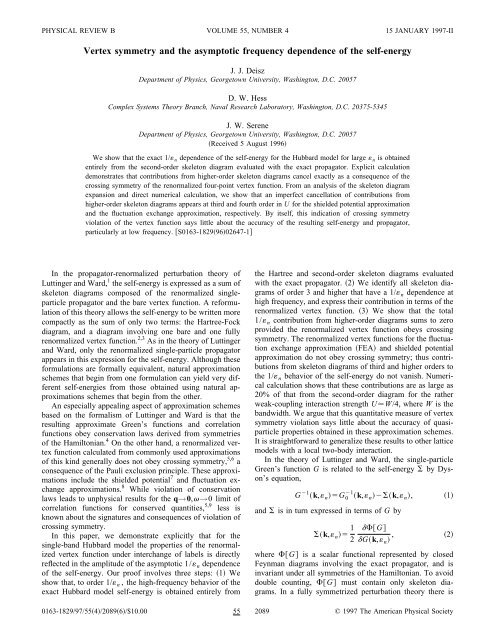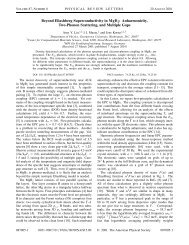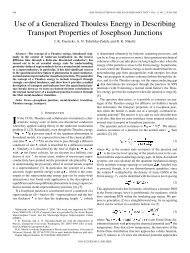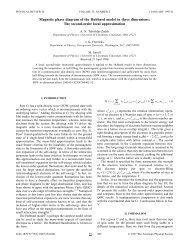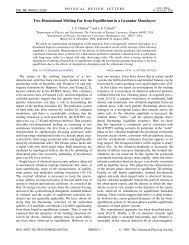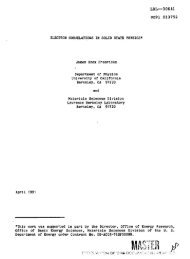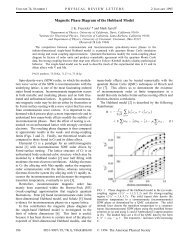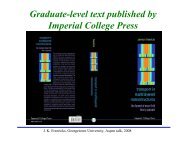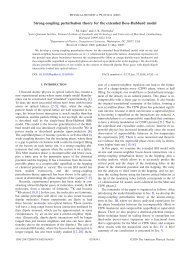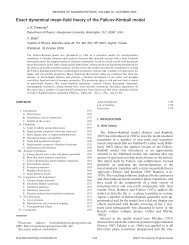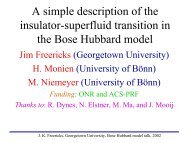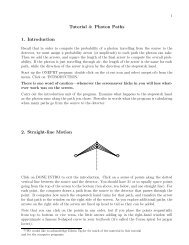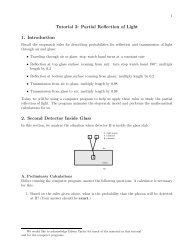Vertex symmetry and the asymptotic frequency dependence of the ...
Vertex symmetry and the asymptotic frequency dependence of the ...
Vertex symmetry and the asymptotic frequency dependence of the ...
Create successful ePaper yourself
Turn your PDF publications into a flip-book with our unique Google optimized e-Paper software.
PHYSICAL REVIEW B<br />
VOLUME 55, NUMBER 4<br />
15 JANUARY 1997-II<br />
<strong>Vertex</strong> <strong>symmetry</strong> <strong>and</strong> <strong>the</strong> <strong>asymptotic</strong> <strong>frequency</strong> <strong>dependence</strong> <strong>of</strong> <strong>the</strong> self-energy<br />
J. J. Deisz<br />
Department <strong>of</strong> Physics, Georgetown University, Washington, D.C. 20057<br />
D. W. Hess<br />
Complex Systems Theory Branch, Naval Research Laboratory, Washington, D.C. 20375-5345<br />
J. W. Serene<br />
Department <strong>of</strong> Physics, Georgetown University, Washington, D.C. 20057<br />
Received 5 August 1996<br />
We show that <strong>the</strong> exact 1/ n <strong>dependence</strong> <strong>of</strong> <strong>the</strong> self-energy for <strong>the</strong> Hubbard model for large n is obtained<br />
entirely from <strong>the</strong> second-order skeleton diagram evaluated with <strong>the</strong> exact propagator. Explicit calculation<br />
demonstrates that contributions from higher-order skeleton diagrams cancel exactly as a consequence <strong>of</strong> <strong>the</strong><br />
crossing <strong>symmetry</strong> <strong>of</strong> <strong>the</strong> renormalized four-point vertex function. From an analysis <strong>of</strong> <strong>the</strong> skeleton diagram<br />
expansion <strong>and</strong> direct numerical calculation, we show that an imperfect cancellation <strong>of</strong> contributions from<br />
higher-order skeleton diagrams appears at third <strong>and</strong> fourth order in U for <strong>the</strong> shielded potential approximation<br />
<strong>and</strong> <strong>the</strong> fluctuation exchange approximation, respectively. By itself, this indication <strong>of</strong> crossing <strong>symmetry</strong><br />
violation <strong>of</strong> <strong>the</strong> vertex function says little about <strong>the</strong> accuracy <strong>of</strong> <strong>the</strong> resulting self-energy <strong>and</strong> propagator,<br />
particularly at low <strong>frequency</strong>. S0163-18299602647-1<br />
In <strong>the</strong> propagator-renormalized perturbation <strong>the</strong>ory <strong>of</strong><br />
Luttinger <strong>and</strong> Ward, 1 <strong>the</strong> self-energy is expressed as a sum <strong>of</strong><br />
skeleton diagrams composed <strong>of</strong> <strong>the</strong> renormalized singleparticle<br />
propagator <strong>and</strong> <strong>the</strong> bare vertex function. A reformulation<br />
<strong>of</strong> this <strong>the</strong>ory allows <strong>the</strong> self-energy to be written more<br />
compactly as <strong>the</strong> sum <strong>of</strong> only two terms: <strong>the</strong> Hartree-Fock<br />
diagram, <strong>and</strong> a diagram involving one bare <strong>and</strong> one fully<br />
renormalized vertex function. 2,3 As in <strong>the</strong> <strong>the</strong>ory <strong>of</strong> Luttinger<br />
<strong>and</strong> Ward, only <strong>the</strong> renormalized single-particle propagator<br />
appears in this expression for <strong>the</strong> self-energy. Although <strong>the</strong>se<br />
formulations are formally equivalent, natural approximation<br />
schemes that begin from one formulation can yield very different<br />
self-energies from those obtained using natural approximations<br />
schemes that begin from <strong>the</strong> o<strong>the</strong>r.<br />
An especially appealing aspect <strong>of</strong> approximation schemes<br />
based on <strong>the</strong> formalism <strong>of</strong> Luttinger <strong>and</strong> Ward is that <strong>the</strong><br />
resulting approximate Green’s functions <strong>and</strong> correlation<br />
functions obey conservation laws derived from symmetries<br />
<strong>of</strong> <strong>the</strong> Hamiltonian. 4 On <strong>the</strong> o<strong>the</strong>r h<strong>and</strong>, a renormalized vertex<br />
function calculated from commonly used approximations<br />
<strong>of</strong> this kind generally does not obey crossing <strong>symmetry</strong>, 5,6 a<br />
consequence <strong>of</strong> <strong>the</strong> Pauli exclusion principle. These approximations<br />
include <strong>the</strong> shielded potential 7 <strong>and</strong> fluctuation exchange<br />
approximations. 8 While violation <strong>of</strong> conservation<br />
laws leads to unphysical results for <strong>the</strong> q→0,→0 limit <strong>of</strong><br />
correlation functions for conserved quantities, 5,9 less is<br />
known about <strong>the</strong> signatures <strong>and</strong> consequences <strong>of</strong> violation <strong>of</strong><br />
crossing <strong>symmetry</strong>.<br />
In this paper, we demonstrate explicitly that for <strong>the</strong><br />
single-b<strong>and</strong> Hubbard model <strong>the</strong> properties <strong>of</strong> <strong>the</strong> renormalized<br />
vertex function under interchange <strong>of</strong> labels is directly<br />
reflected in <strong>the</strong> amplitude <strong>of</strong> <strong>the</strong> <strong>asymptotic</strong> 1/ n <strong>dependence</strong><br />
<strong>of</strong> <strong>the</strong> self-energy. Our pro<strong>of</strong> involves three steps: 1 We<br />
show that, to order 1/ n , <strong>the</strong> high-<strong>frequency</strong> behavior <strong>of</strong> <strong>the</strong><br />
exact Hubbard model self-energy is obtained entirely from<br />
<strong>the</strong> Hartree <strong>and</strong> second-order skeleton diagrams evaluated<br />
with <strong>the</strong> exact propagator. 2 We identify all skeleton diagrams<br />
<strong>of</strong> order 3 <strong>and</strong> higher that have a 1/ n <strong>dependence</strong> at<br />
high <strong>frequency</strong>, <strong>and</strong> express <strong>the</strong>ir contribution in terms <strong>of</strong> <strong>the</strong><br />
renormalized vertex function. 3 We show that <strong>the</strong> total<br />
1/ n contribution from higher-order diagrams sums to zero<br />
provided <strong>the</strong> renormalized vertex function obeys crossing<br />
<strong>symmetry</strong>. The renormalized vertex functions for <strong>the</strong> fluctuation<br />
exchange approximation FEA <strong>and</strong> shielded potential<br />
approximation do not obey crossing <strong>symmetry</strong>; thus contributions<br />
from skeleton diagrams <strong>of</strong> third <strong>and</strong> higher orders to<br />
<strong>the</strong> 1/ n behavior <strong>of</strong> <strong>the</strong> self-energy do not vanish. Numerical<br />
calculation shows that <strong>the</strong>se contributions are as large as<br />
20% <strong>of</strong> that from <strong>the</strong> second-order diagram for <strong>the</strong> ra<strong>the</strong>r<br />
weak-coupling interaction strength UW/4, where W is <strong>the</strong><br />
b<strong>and</strong>width. We argue that this quantitative measure <strong>of</strong> vertex<br />
<strong>symmetry</strong> violation says little about <strong>the</strong> accuracy <strong>of</strong> quasiparticle<br />
properties obtained in <strong>the</strong>se approximation schemes.<br />
It is straightforward to generalize <strong>the</strong>se results to o<strong>the</strong>r lattice<br />
models with a local two-body interaction.<br />
In <strong>the</strong> <strong>the</strong>ory <strong>of</strong> Luttinger <strong>and</strong> Ward, <strong>the</strong> single-particle<br />
Green’s function G is related to <strong>the</strong> self-energy by Dyson’s<br />
equation,<br />
G 1 k, n G 0 1 k, n k, n ,<br />
<strong>and</strong> is in turn expressed in terms <strong>of</strong> G by<br />
k, n 1 G<br />
2 Gk, n ,<br />
2<br />
where G is a scalar functional represented by closed<br />
Feynman diagrams involving <strong>the</strong> exact propagator, <strong>and</strong> is<br />
invariant under all symmetries <strong>of</strong> <strong>the</strong> Hamiltonian. To avoid<br />
double counting, G must contain only skeleton diagrams.<br />
In a fully symmetrized perturbation <strong>the</strong>ory <strong>the</strong>re is<br />
1<br />
0163-1829/97/554/20896/$10.00 55 2089 © 1997 The American Physical Society
2090 J. J. DEISZ, D. W. HESS, AND J. W. SERENE<br />
55<br />
k, n 0 k k<br />
k<br />
i n i n 2 •••. 5<br />
Here we have included a n -independent term 0 (k), in <strong>the</strong><br />
expansion; such a term cannot occur in <strong>the</strong> expansion for<br />
G. 10 We relate <strong>the</strong> high- n behavior <strong>of</strong> G <strong>and</strong> by substituting<br />
Eqs. 3 <strong>and</strong> 5 into Eq. 1, <strong>and</strong> identifying terms <strong>of</strong> <strong>the</strong><br />
same order in 1/ n . Using G 1 o (k, n )i n k with<br />
k k , where k <strong>and</strong> are <strong>the</strong> noninteracting singleparticle<br />
energy <strong>and</strong> renormalized chemical potential, respectively,<br />
we obtain <strong>the</strong> following relations:<br />
Gk1,<br />
Gk k 0 k,<br />
Gk k 0 k 2 k.<br />
6a<br />
6b<br />
6c<br />
From <strong>the</strong> expression for G in <strong>the</strong> Heisenberg representation,<br />
Gk,T e K c k e K c k † ,<br />
it is straightforward to show that<br />
7<br />
FIG. 1. a Hartree <strong>and</strong> b second-order self-energy diagrams<br />
for <strong>the</strong> Hubbard model. The entire <strong>frequency</strong>-independent contribution<br />
to <strong>the</strong> Hubbard model self-energy is obtained by evaluating <strong>the</strong><br />
diagram a with <strong>the</strong> exact propagator, while <strong>the</strong> entire 1/ n <strong>dependence</strong><br />
<strong>of</strong> <strong>the</strong> Hubbard model self-energy is obtained by evaluating<br />
<strong>the</strong> diagram b with <strong>the</strong> exact propagator.<br />
exactly one first-order skeleton diagram <strong>the</strong> Hartree diagram<br />
<strong>and</strong> one second-order skeleton diagram for <strong>the</strong> selfenergy;<br />
both are shown in Fig. 1.<br />
The behavior <strong>of</strong> G <strong>and</strong> at high <strong>frequency</strong> n depends on<br />
<strong>the</strong>ir smoothness in imaginary time . The functional <strong>dependence</strong><br />
<strong>of</strong> G <strong>and</strong> at high <strong>frequency</strong> can be connected to<br />
discontinuities in G <strong>and</strong> <strong>and</strong> <strong>the</strong>ir derivatives at 0 by<br />
repeated integration by parts <strong>of</strong> <strong>the</strong> Fourier integral,<br />
where<br />
Gk, n <br />
0<br />
<br />
Gk,e<br />
i n d<br />
Gk<br />
••• 1p1 G p k<br />
i n<br />
i n p1<br />
1p1<br />
i n p1 <br />
0<br />
<br />
e<br />
i n p1 Gk,<br />
p1 d, 3<br />
G p k d p Gk,<br />
d p d p Gk,<br />
d<br />
→0 p , 4 →0 <br />
<strong>and</strong> we have used G(k, )G(k,0 ). The final term in<br />
Eq. 3 approaches zero faster than 1/ n p1 , because<br />
G(k,) is infinitely differentiable on <strong>the</strong> open interval<br />
(0,). We can represent <strong>the</strong> high- n behavior <strong>of</strong> by an<br />
expansion analogous to Eq. 3,<br />
G p kK,c k p ,c k † ,<br />
where KHN, <strong>and</strong> K,c k p is <strong>the</strong> usual commutator iterated<br />
p times K,K, ...K,c k ... <strong>and</strong> defined to be<br />
c k for p0. In passing we note that <strong>the</strong> p-fold ‘‘nested’’<br />
commutator is also proportional to <strong>frequency</strong> moments <strong>of</strong> <strong>the</strong><br />
single-particle spectral function A(k,), 11<br />
p <br />
<br />
<br />
p Ak,d1 p1 G p k.<br />
For <strong>the</strong> Hubbard model it is straightforward to evaluate Eq.<br />
8 for p0, 1, <strong>and</strong> 2; 11,12 <strong>the</strong> results are<br />
Gk1,<br />
Gk k Un/2,<br />
Gk k 2 U k U 2 n/2.<br />
8<br />
9<br />
10a<br />
10b<br />
10c<br />
Here n is <strong>the</strong> exact density <strong>of</strong> <strong>the</strong> interacting system. Upon<br />
substitution <strong>of</strong> Eqs. 10b <strong>and</strong> 10c into Eqs. 6b <strong>and</strong> 6c,<br />
<strong>the</strong> exact n -independent <strong>and</strong> 1/ n contributions to are<br />
obtained; in r space <strong>the</strong>se are given by<br />
o rU n 2 r,0 ,<br />
rU 21 n 2 n 2 r,0.<br />
11<br />
12<br />
Direct evaluation <strong>of</strong> <strong>the</strong> <strong>asymptotic</strong> n <strong>dependence</strong> <strong>of</strong> <strong>the</strong><br />
two lowest-order skeleton graphs for leads to forms similar<br />
to Eqs. 11 <strong>and</strong> 12. The first-order skeleton diagram for<br />
is <strong>the</strong> Hartree diagram shown in Fig. 1a, <strong>and</strong> yields a<br />
<strong>frequency</strong>-independent contribution to <strong>the</strong> self-energy given<br />
by
55 VERTEX SYMMETRY AND THE ASYMPTOTIC . . .<br />
2091<br />
H rU ñ 2 r,0 ,<br />
13<br />
where ñ is <strong>the</strong> density calculated from <strong>the</strong> trace <strong>of</strong><br />
G(k, n ). If ñ is equal to <strong>the</strong> exact density ei<strong>the</strong>r because<br />
G is <strong>the</strong> true Green’s function or as a consequence <strong>of</strong> special<br />
circumstances such as <strong>the</strong> particle-hole <strong>symmetry</strong> <strong>of</strong> <strong>the</strong> halffilled<br />
Hubbard model, <strong>the</strong>n <strong>the</strong> Hartree contribution to <br />
gives <strong>the</strong> exact n -independent component. This is not a surprising<br />
result. The Hartree diagram is <strong>the</strong> only skeleton diagram<br />
that is independent <strong>of</strong> <strong>the</strong> external <strong>frequency</strong>, so it must<br />
fully account for o (r).<br />
In <strong>the</strong> (r,) representation, <strong>the</strong> second-order skeleton diagram,<br />
shown in Fig. 1b, is<br />
2 r,U 2 G 2 r,Gr,.<br />
14<br />
The single-particle propagator is discontinuous only for<br />
r0, with G(0 )1ñ/2 <strong>and</strong> G(0 )ñ/2. This yields<br />
2 rU 21 ñ 2 ñ 2 r,0.<br />
15<br />
Evaluation <strong>of</strong> Eq. 15 with <strong>the</strong> exact propagator ensures that<br />
ñ is <strong>the</strong> true density, <strong>and</strong> comparison with Eq. 12 shows<br />
that<br />
exact 2 G exact .<br />
16<br />
Thus, when evaluated with <strong>the</strong> exact G, <strong>the</strong> second-order<br />
skeleton diagram, shown in Fig. 1b, gives <strong>the</strong> entire 1/ n<br />
contribution to .<br />
This result is perhaps surprising given that <strong>the</strong>re is an<br />
infinite set <strong>of</strong> third- <strong>and</strong> higher-order skeleton diagrams that<br />
individually have <strong>asymptotic</strong> 1/ n <strong>dependence</strong>s. All members<br />
<strong>of</strong> this class <strong>of</strong> diagrams have a single unbroken Green’s<br />
function line joining <strong>the</strong> two external vertices along with<br />
ei<strong>the</strong>r particle-hole fluctuation or particle-particle fluctuation<br />
diagrams as shown in Fig. 2. The 0 discontinuity results<br />
from <strong>the</strong> unbroken Green’s function line for r0; <strong>the</strong><br />
particle-hole <strong>and</strong> particle-particle fluctuation diagrams are<br />
continuous, <strong>and</strong> <strong>the</strong>ir values at (r0,0) scale <strong>the</strong> amplitude<br />
<strong>of</strong> <strong>the</strong> discontinuity for each such self-energy diagram.<br />
When <strong>the</strong>re is no unbroken Green’s-function line connecting<br />
<strong>the</strong> two bare external vertices in a given skeleton diagram,<br />
integration over intermediate coordinates smooths any discontinuity<br />
from individual Green’s functions leaving a function<br />
that is continuous at 0. Such diagrams appear at<br />
fourth <strong>and</strong> higher orders, <strong>and</strong> contribute to order 1/ n 2 <strong>and</strong><br />
higher; <strong>the</strong>y will not be considered fur<strong>the</strong>r here.<br />
Equation 16 implies that <strong>the</strong> contributions to from<br />
third- <strong>and</strong> higher-order terms cancel exactly. To see how this<br />
cancellation arises, consider <strong>the</strong> class <strong>of</strong> diagrams in Fig. 2<br />
with renormalized particle-hole <strong>and</strong> particle-particle vertices,<br />
ph <strong>and</strong> pp . 13 Using Fig. 2 <strong>and</strong> <strong>the</strong> labeling conventions<br />
established <strong>the</strong>re, we obtain<br />
n3 U 2 dx 1 dx 2 dx 3 dx 4 Gx 1 Gx 2 Gx 3 Gx 4 <br />
↓↓;↓↓ ph ↑↓;↑↓ ph ↑↓;↑↓ pp x 1 x 2 ;x 3 x 4 ,<br />
17<br />
FIG. 2. The set <strong>of</strong> all a particle-hole <strong>and</strong> b particle-particle<br />
fluctuation diagrams for <strong>the</strong> self-energy that individually have a<br />
1/ n <strong>frequency</strong> <strong>dependence</strong> at high <strong>frequency</strong>. The net contribution<br />
to <strong>the</strong> 1/ n <strong>dependence</strong> is zero when ph <strong>and</strong> pp satisfy vertex<br />
labeling symmetries see text.<br />
where x(r,) <strong>and</strong> dx r 0 d. The relative minus sign<br />
between particle-hole <strong>and</strong> particle-particle contributions reflects<br />
<strong>the</strong> opposite sense in <strong>of</strong> <strong>the</strong> unbroken G. A twist <strong>of</strong><br />
<strong>the</strong> corners labeled ‘‘2’’ <strong>and</strong> ‘‘4’’ in pp yields ph , i.e.,<br />
↑↓;↑↓ pp (x 1 x 2 ;x 3 x 4 ) ↑↓;↑↓ ph (x 1 x 2 ;x 3 x 4 ), <strong>and</strong> <strong>the</strong> expression<br />
for n3 becomes<br />
n3 U 2 dx 1 dx 2 dx 3 dx 4 Gx 1 Gx 2 Gx 3 <br />
Gx 4 ↓↓;↓↓ ph x 1 x 2 ;x 3 x 4 . 18<br />
Using <strong>the</strong> <strong>symmetry</strong> <strong>of</strong> <strong>the</strong> vertex function under <strong>the</strong> interchange<br />
<strong>of</strong> outgoing labels ‘‘crossing <strong>symmetry</strong>’’,<br />
↓↓;↓↓ ph (x 1 x 2 ;x 3 x 4 ) ↓↓;↓↓ ph (x 1 x 2 ;x 4 x 3 ) leads us to <strong>the</strong> result<br />
n3 n3 ,or n3 0.<br />
It is important to observe that <strong>the</strong> result n3 0 reflects<br />
<strong>the</strong> form <strong>of</strong> <strong>the</strong> self-energy at high <strong>frequency</strong>, <strong>and</strong> is<br />
entirely a consequence <strong>of</strong> <strong>the</strong> <strong>symmetry</strong> <strong>of</strong> <strong>the</strong> vertex function<br />
under <strong>the</strong> interchange <strong>of</strong> labels. If this relation holds for<br />
a vertex function obtained in a particular approximation, no<br />
direct statement regarding <strong>the</strong> accuracy <strong>of</strong> G particularly for<br />
low frequencies is possible from this information alone.<br />
The essential symmetries <strong>of</strong> <strong>the</strong> fully renormalized vertex<br />
used in this pro<strong>of</strong> are not always satisfied by vertex functions<br />
obtained in approximate calculations. One such approximation<br />
scheme <strong>of</strong> current interest is <strong>the</strong> fluctuation exchange<br />
approximation FEA, 8 which has received considerable attention<br />
as a means for exploring <strong>the</strong> relationship between
2092 J. J. DEISZ, D. W. HESS, AND J. W. SERENE<br />
55<br />
FIG. 3. Ratio <strong>of</strong> <strong>the</strong> discontinuity at 0 in <strong>the</strong> self-energy to<br />
<strong>the</strong> discontinuity obtained from <strong>the</strong> second-order diagram,<br />
/ 2 , evaluated with <strong>the</strong> renormalized propagator at temperature<br />
T0.1t for <strong>the</strong> fluctuation exchange approximation <strong>and</strong> <strong>the</strong><br />
particle-hole fluctuation approximation. For <strong>the</strong> exact solution to<br />
<strong>the</strong> Hubbard model / 2 is identically unity. The deviation<br />
from unity shown is a consequence <strong>of</strong> <strong>the</strong> violation <strong>of</strong> crossing<br />
<strong>symmetry</strong> <strong>of</strong> <strong>the</strong> renormalized two-particle vertex function resulting<br />
from <strong>the</strong> omission <strong>of</strong> skeleton diagrams from <strong>the</strong> vertex function.<br />
For <strong>the</strong> particle-hole fluctuation approximation fluctuation exchange<br />
approximation <strong>the</strong> lowest-order omission in <strong>the</strong> skeleton<br />
diagram expansion for <strong>the</strong> self-energy is at order U 3 (U 4 ), resulting<br />
in a leading departure <strong>of</strong> / 2 from unity that is linear quadratic<br />
in U.<br />
anomalous quasiparticle excitations, superconductivity, <strong>and</strong><br />
antiferromagnetic correlations in layered copper-oxide compounds.<br />
The absence <strong>of</strong> <strong>the</strong>se symmetries in <strong>the</strong> FEA is demonstrated<br />
in Fig. 3, where / 2 is plotted as a function<br />
<strong>of</strong> U for half-filling in two dimensions. 14 For modest coupling,<br />
e.g., U/t2, a deviation from unity <strong>of</strong> order 20%<br />
occurs. The deviation is quadratic in U which is easily understood<br />
by substituting into Eq. 17 <strong>the</strong> second-order parts<br />
<strong>of</strong> <strong>the</strong> FEA particle-hole <strong>and</strong> particle-particle vertices:<br />
↑↓;↑↓ U 2 (x 1 x 4 )(x 2 x 3 )G(x 1 x 2 )G(x 2 x 1 )<br />
↓↓;↓↓ ph ph<br />
<strong>and</strong> ↑↓;↑↓ pp U 2 (x 1 x 2 )(x 3 x 4 )G 2 (x 1 x 3 ). This yields<br />
a fourth-order contribution to <strong>the</strong> discontinuity that is equal<br />
to<br />
4 U 4 dx 1 dx 2 2Gx 1 Gx 2 Gx 2 x 1 Gx 1 x 2 <br />
Gx 2 Gx 1 G 2 x 1 G 2 x 2 x 1 G 2 x 2 .<br />
19<br />
Fur<strong>the</strong>r calculation shows that 4 would be cancelled exactly<br />
by including all <strong>the</strong> second-order vertex diagrams omitted<br />
in <strong>the</strong> FEA. Examination <strong>of</strong> <strong>the</strong> explicit expressions for<br />
<strong>the</strong> second-order parts <strong>of</strong> <strong>the</strong> FEA vertex function shows that<br />
without including <strong>the</strong>se diagrams <strong>the</strong> vertex function possesses<br />
nei<strong>the</strong>r <strong>of</strong> <strong>the</strong> two symmetries used to show<br />
n3 0.<br />
The shielded potential or particle-hole approximation reduces<br />
<strong>the</strong> set <strong>of</strong> FEA diagrams by omitting <strong>the</strong> particleparticle<br />
ladder diagrams. As a consequence, contributions to<br />
appear at third order,<br />
FIG. 4. Dependence <strong>of</strong> / 2 on a filling, <strong>and</strong> b temperature<br />
in <strong>the</strong> fluctuation exchange approximation for <strong>the</strong> Hubbard<br />
model in two dimensions. The filling <strong>dependence</strong> is strong as is<br />
expected since <strong>the</strong> many-body correlations represented by become<br />
weak in <strong>the</strong> dilute limit for a local repulsive interaction. However,<br />
<strong>the</strong> temperature variation is weak even though fluctuation<br />
propagators are strongly renormalized in this temperature range.<br />
3 U 3 dx G 2 xG 2 x.<br />
20<br />
Thus, as shown Fig. 3, <strong>the</strong> departure from unity <strong>of</strong> <strong>the</strong> normalized<br />
is linear in U. 15<br />
Clearly, / 2 provides a direct indication <strong>of</strong> <strong>the</strong> violation<br />
<strong>of</strong> vertex <strong>symmetry</strong> <strong>and</strong> <strong>the</strong> order at which <strong>the</strong> violation<br />
first occurs; but does it characterize <strong>the</strong> accuracy <strong>of</strong> quasiparticle<br />
properties obtained in <strong>the</strong>se approximation<br />
schemes? To consider this question, we display <strong>the</strong> filling<br />
<strong>dependence</strong> <strong>of</strong> / 2 in Fig. 4a. Since multiparticle correlations<br />
become weaker in <strong>the</strong> dilute limit for a repulsive<br />
local interaction, it is not surprising that <strong>the</strong> deviations from<br />
unity are smallest at lower fillings. At <strong>the</strong> same time, it has<br />
been shown numerically that FEA results for G are poorer<br />
away from half-filling. 8 This provides at least one case where<br />
<strong>the</strong> size <strong>of</strong> <strong>the</strong> departure <strong>of</strong> / 2 from unity does not<br />
correlate with <strong>the</strong> accuracy <strong>of</strong> <strong>the</strong> renormalized G.<br />
It is also worth evaluating <strong>the</strong> <strong>dependence</strong> <strong>of</strong> / 2 on<br />
o<strong>the</strong>r parameters which strongly affect <strong>the</strong> FEA’s behavior<br />
<strong>and</strong>, possibly, accuracy. Figure 4b displays <strong>the</strong> temperature<br />
<strong>dependence</strong> <strong>of</strong> / 2 at half-filling in two dimensions.<br />
For U2t <strong>and</strong> near <strong>the</strong> lower temperature shown, <strong>the</strong> spin<br />
fluctuation propagator becomes nearly singular around<br />
q(,) <strong>and</strong> m 0, producing a non-Fermi-liquid<br />
self-energy. 16 This dramatic temperature-driven change in<br />
<strong>the</strong> self-energy at low energies does not result in a strong<br />
temperature <strong>dependence</strong> <strong>of</strong> / 2 .<br />
Likewise, as shown in Fig. 5, <strong>the</strong>re is little <strong>dependence</strong> on<br />
lattice dimension, d, for a fixed ratio <strong>of</strong> U to td 1/2 . This<br />
scaling <strong>of</strong> U removes <strong>the</strong> trivial <strong>dependence</strong> that arises from<br />
<strong>the</strong> increase <strong>of</strong> <strong>the</strong> b<strong>and</strong>width with dimensionality. Thus we
55 VERTEX SYMMETRY AND THE ASYMPTOTIC . . .<br />
2093<br />
FIG. 5. Dependence <strong>of</strong> / 2 on lattice dimension d for<br />
n1 <strong>and</strong> T0.1. The Hubbard interaction U has been scaled by<br />
<strong>the</strong> factor td 1/2 which is proportional to <strong>the</strong> large-d expression for<br />
<strong>the</strong> b<strong>and</strong>width. The / 2 shown are nearly independent <strong>of</strong> d.<br />
see no sign <strong>of</strong> an enhancement <strong>of</strong> crossing <strong>symmetry</strong> violation<br />
as <strong>the</strong> lattice dimension is lowered, although it is expected<br />
that <strong>the</strong> FEA will become less accurate.<br />
It has been argued 17 that <strong>the</strong> appearance <strong>of</strong> a satellite<br />
structure in <strong>the</strong> single-particle spectral function for <strong>the</strong><br />
Anderson lattice model ALM is a consequence <strong>of</strong> <strong>the</strong> high<strong>frequency</strong><br />
behavior <strong>of</strong> <strong>the</strong> self-energy. For <strong>the</strong> simplest form<br />
<strong>of</strong> <strong>the</strong> Anderson lattice model, <strong>the</strong> only two-body interaction<br />
occurs between f electrons, <strong>and</strong> <strong>the</strong> self-energy is given entirely<br />
by skeleton diagrams involving only f -electron propagators.<br />
As in <strong>the</strong> case <strong>of</strong> <strong>the</strong> Hubbard model, <strong>the</strong> contributions<br />
<strong>of</strong> skeleton diagrams <strong>of</strong> order 3 <strong>and</strong> higher to <strong>the</strong><br />
discontinuity <strong>of</strong> <strong>the</strong> self-energy at 0 vanishes, <strong>and</strong> <strong>the</strong><br />
high-<strong>frequency</strong> behavior <strong>of</strong> f is given entirely by <strong>the</strong><br />
second-order diagram evaluated with <strong>the</strong> fully renormalized<br />
f -electron propagator. The leading high-<strong>frequency</strong> <strong>dependence</strong><br />
<strong>of</strong> <strong>the</strong> self-energy is given by Eq. 15, with ñ as <strong>the</strong><br />
f -electron density. For <strong>the</strong> symmetric ALM, <strong>the</strong> average<br />
f -electron occupancy is constrained to be unity by particlehole<br />
<strong>symmetry</strong>, <strong>and</strong> we find that at high <strong>frequency</strong> <strong>the</strong> exact<br />
self-energy goes as →U 2 /4. This exact result turns out to<br />
be <strong>the</strong> same as that obtained for <strong>the</strong> atomic model in Sec. III<br />
<strong>of</strong> Ref. 17, which places all f -electron spectral weight in<br />
satellite peaks at U/2, a result that is strictly valid only in<br />
<strong>the</strong> U→ limit. Although it is most accurate for small U,<br />
second-order perturbation <strong>the</strong>ory also duplicates <strong>the</strong> exact<br />
high-energy result as a consequence <strong>of</strong> particle-hole<br />
<strong>symmetry</strong>. 17 Thus, while f -electron satellites at U/2 are<br />
consistent with <strong>the</strong> high-energy behavior <strong>of</strong> <strong>the</strong> exact selfenergy,<br />
<strong>the</strong> existence <strong>of</strong> qualitatively different approximations<br />
with <strong>the</strong> same high-<strong>frequency</strong> behavior as <strong>the</strong> exact<br />
self-energy shows that this signature <strong>of</strong> crossing <strong>symmetry</strong><br />
places little if any constraint on <strong>the</strong> accuracy <strong>of</strong> <strong>the</strong> selfenergy<br />
at low energy.<br />
In summary, we have demonstrated a property <strong>of</strong> <strong>the</strong> exact<br />
self-energy <strong>of</strong> <strong>the</strong> Hubbard model; <strong>the</strong> leading <strong>asymptotic</strong><br />
<strong>frequency</strong> <strong>dependence</strong> <strong>of</strong> <strong>the</strong> self-energy is provided entirely<br />
by <strong>the</strong> Hartree <strong>and</strong> second-order skeleton diagrams. The<br />
<strong>frequency</strong>-independent contribution to <strong>the</strong> self-energy is obtained<br />
from <strong>the</strong> Hartree diagram as expected. The leading<br />
1/ n behavior is obtained entirely from <strong>the</strong> second-order<br />
skeleton diagram, <strong>and</strong> reflects a perfect cancellation <strong>of</strong> <strong>the</strong><br />
contributions to order 1/ n <strong>of</strong> an infinite class <strong>of</strong> higher-order<br />
diagrams, which we have shown depend only on <strong>the</strong> labeling<br />
<strong>symmetry</strong> <strong>of</strong> <strong>the</strong> renormalized vertex function. Numerical<br />
calculation shows substantial deviations in <strong>the</strong> fluctuation exchange<br />
<strong>and</strong> shielded potential approximations, where <strong>the</strong><br />
vertex functions do not obey <strong>the</strong>se symmetries. However,<br />
<strong>the</strong>se numerical results suggest that this indicator <strong>of</strong><br />
crossing-<strong>symmetry</strong> violation in <strong>and</strong> <strong>of</strong> itself does not provide<br />
information on <strong>the</strong> accuracy <strong>of</strong> <strong>the</strong> resulting self-energy <strong>and</strong><br />
propagator, particularly at low energy.<br />
ACKNOWLEDGMENTS<br />
We thank M. Steiner for bringing Ref. 12 to our attention.<br />
J.D. <strong>and</strong> J.S. were supported by National Science Foundation<br />
Grant No. ASC-9504067; D.W.H. was supported by <strong>the</strong> Office<br />
<strong>of</strong> Naval Research. Numerical work presented was supported<br />
in part by a grant <strong>of</strong> computer time from <strong>the</strong> Department<br />
<strong>of</strong> Defense High-Performance Computing Shared<br />
Resource Center, Naval Research Laboratory Connection<br />
Machine Facility CM-5. D.H. would like to acknowledge <strong>the</strong><br />
kind hospitality <strong>of</strong> <strong>the</strong> Universität Bayreuth during <strong>the</strong> preparation<br />
<strong>of</strong> this manuscript.<br />
1 J. M. Luttinger <strong>and</strong> J. C. Ward, Phys. Rev. 118, 1417 1960.<br />
2 See, for example, A. A. Abrikosov, L. P. Gorkov, <strong>and</strong> I. E. Dzyaloshinski,<br />
Methods <strong>of</strong> Quantum Field Theory in Statistical<br />
Physics Dover, New York, 1975, pp. 87 <strong>and</strong> 88.<br />
3 C. de Dominicis <strong>and</strong> P. C. Martin, J. Math. Phys. 5, 141964.<br />
4 G. Baym, Phys. Rev. 127, 1391 1962.<br />
5 N. E. Bickers <strong>and</strong> S. R. White, Phys. Rev. B 43, 8044 1991.<br />
6 See, for example, D. J. Amit, J. W. Kane <strong>and</strong> H. Wagner, Phys.<br />
Rev. 175, 326 1968.<br />
7 G. Baym <strong>and</strong> L. Kadan<strong>of</strong>f, Quantum Statistical Mechanics Benjamin,<br />
New York, 1962.<br />
8 N. E. Bickers, D. J. Scalapino, <strong>and</strong> S. R. White, Phys. Rev. Lett.<br />
62, 961 1989.<br />
9 G. Baym <strong>and</strong> L. P. Kadan<strong>of</strong>f, Phys. Rev. 124, 287 1961.<br />
10 J. M. Luttinger, Phys. Rev. 121, 942 1961.<br />
11 S. R. White, Phys. Rev. B 44, 4670 1991.<br />
12 W. Nolting, Z. Phys. 255, 251972.<br />
13 This argument may also be cast in terms <strong>of</strong> local, equal-time<br />
susceptibilities. The contribution <strong>of</strong> <strong>the</strong> diagrams <strong>of</strong> Fig. 2 to <strong>the</strong><br />
0 discontinuity can <strong>the</strong>n be written as<br />
n3 U 2 1 4 0,0 1 4 0,0 pp 0,0n,<br />
where<br />
0,0<br />
<br />
0,0 c † c c † c ,<br />
,↑,↓<br />
<br />
ix,y,z,,↑,↓<br />
pp 0,0c ↑ † c ↓ † c ↓ c ↑ ;<br />
i i c † c c † c ,
2094 J. J. DEISZ, D. W. HESS, AND J. W. SERENE<br />
55<br />
<strong>and</strong> all fermion operators have identical space <strong>and</strong> time indices.<br />
These local, equal-time susceptibilities can be expressed in<br />
terms <strong>of</strong> two parameters, c ↑ † c ↑ c ↓ † c ↓ <strong>and</strong> n, <strong>and</strong> n3 is easily<br />
seen to be zero.<br />
14 We use <strong>the</strong> algorithm reported by J. J. Deisz, D. W. Hess, <strong>and</strong> J.<br />
W. Serene, in Recent Progress in Many-Body Theories, edited<br />
by E. Schachinger, H. Mitter, <strong>and</strong> H. Sormann Plenum, New<br />
York, 1995, Vol. 4 to calculate <strong>the</strong> FEA self-energy <strong>and</strong>, in<br />
particular, its discontinuity at 0.<br />
15 The same conclusions follow, but with an opposite sign for<br />
3 , for <strong>the</strong> T approximation, where only particle-particle ladder<br />
diagrams are included in .<br />
16 J. J. Deisz, D. W. Hess, <strong>and</strong> J. W. Serene, Phys. Rev. Lett. 76,<br />
1312 1996.<br />
17 M. Steiner, R. C. Albers, D. J. Scalapino, <strong>and</strong> L. J. Sham, Phys.<br />
Rev. B 43, 1637 1991.


